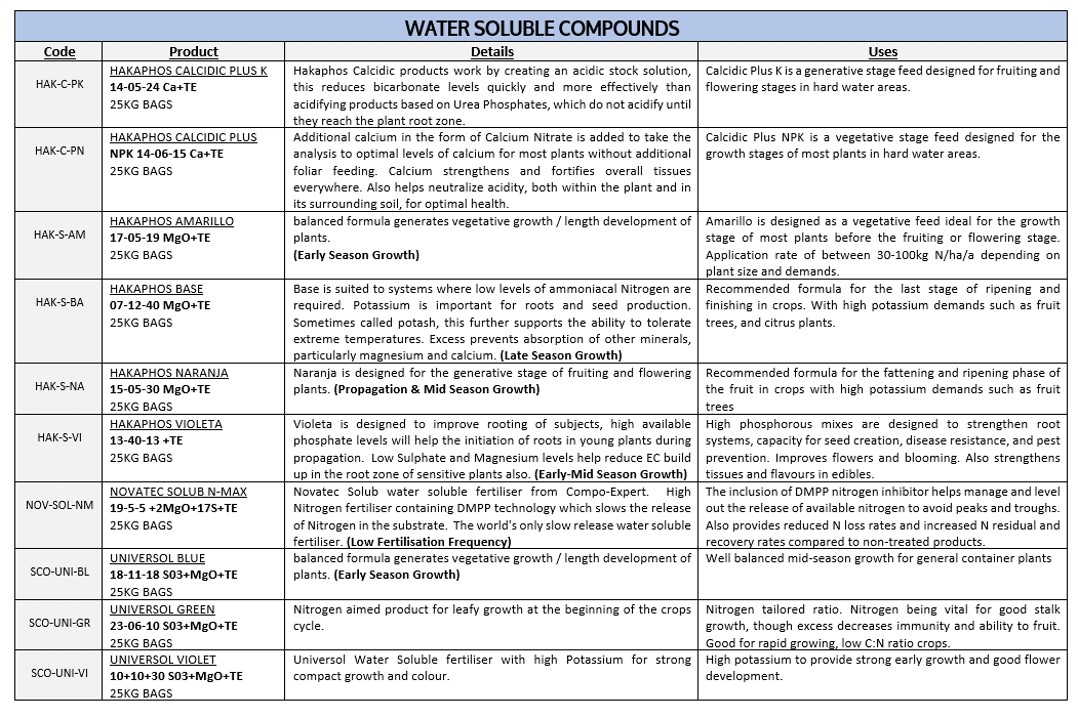
In a natural ecosystem, plant essential nutrients are supplied from nutrient recycling of leaf litter and atmospheric deposition. 90% of the most important nutrients (nitrogen, phosphorous and potassium) are mulched and recycled back into the soil solution. Container grown shrubs and trees however cannot access the amounts of nutrition required to maintain healthy and unrestricted top-growth, without the addition of organic/inorganic fertilisers.
Trying to determine a fertilising regime on a nursery growing a broad range of species at varying sizes can become an overwhelming task, particularly in the case of fertigation systems. Combining these factors with climatic variations, time of year, internal nutrient redistribution, legume vs non-legume species and any abiotic stress means that fertilising often is a matter of judgement based on logic and experience.
The starting point for plant nutrition is understanding the difference between macro and micro nutrition, all of which are essential for growth, but required in varying quantities. Nitrogen, potassium, phosphorous, calcium, magnesium and sulphur would be classed as the macro nutrients. Other elements such as manganese, copper, molybdenum, zinc and boron are micro nutrients and required in much smaller amounts. Recent studies have also shown other nutrients previously not classified as essential for a plant to complete its full life cycle but advantageous for biomass development, include silicon and salicylic acid. As stated, the dynamics of measuring exact plant requirements can be exceptionally difficult. Regular monitoring alongside soil sampling, tissue tests and fundamental plant growth concepts help us develop programmes for the management of trees in cultivation.
How do I work out the quantity and ratio of base elements I should be applying? To answer this question, we feel it is most helpful to reference studies made of natural ecosystems, in this case deciduous forests. It has been identified that average annual values of nutrient uptake equal 75kg nitrogen, 51kg potassium and 6kg phosphorus per hectare (Landsberg and Gower, 1997). To make these figures more relatable to an individual tree, we can assume that a semi-mature tree covers 25m2. This would equate to 190, 130 and 2 grams of nitrogen, potassium and phosphorous respectively per tree, each year. Figures broadly would be lower than this for evergreen species where it is more energy efficient to hold onto foliage for longer. Nevertheless, we end up with an NPK ratio of 80-1-65. Given the fact the actual volume of soil in container grown tree and shrub production is much lower than in a naturally occurring situation and phosphorous is an essential element for ATP (Adenosine triphosphate) production alongside root development, it would be logical to supplement plants with additional phosphorous. Often very little phosphate is readily available to plants so either the addition of extra phosphate or applying in combination with Bacillus amyloliquefaciens will help improve availability. A ratio closer to 20-4-16 would be technically acceptable. This is somewhat of a simplified equation and the ratio will vary in circumstances such as heavily flowering and fruiting trees requiring higher potassium demands and nitrogen fixing species such as Laburnum and Robina where much less nitrogen is needed.
The tables below have been collated summarising grower options available. These analyses can be interpreted at a grower level or in combination with FACTS qualified adviser knowledge.



